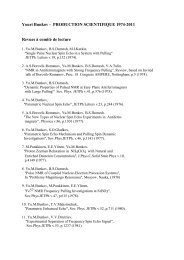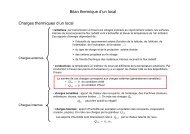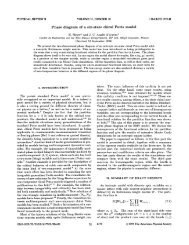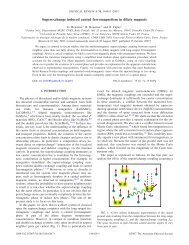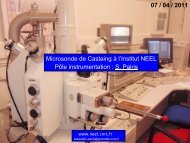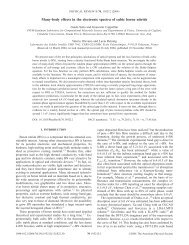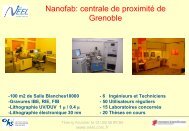Activity Report 2010 - CNRS
Activity Report 2010 - CNRS
Activity Report 2010 - CNRS
You also want an ePaper? Increase the reach of your titles
YUMPU automatically turns print PDFs into web optimized ePapers that Google loves.
SCIENTIFIC REPORT<br />
FURTHER READING:<br />
[10] Phys. Rev. B 81, 245315 (<strong>2010</strong>).<br />
Optical initialization, readout, and dynamics<br />
of a Mn spin in a quantum dot<br />
Semiconductor<br />
quantum<br />
dots<br />
Chair of Excellence 2007: Joaquin<br />
FERNANDEZ-ROSSIER<br />
Coordinator: Henri MARIETTE (Institut<br />
Néel).<br />
Electron spins confined in quantum dots<br />
(QDs) are one of the proposed physical<br />
realizations for a qubit. The most studied<br />
system is a QD defined by gating a 2D<br />
electron gas in GaAs. Two original<br />
systems based on self-assembled QDs<br />
are studied within programs of the<br />
Nanosciences Foundation: a single<br />
magnetic impurity in a QD, and Si-Ge<br />
QDs (see the Quantum Electronics<br />
report).<br />
Thanks to the strong spin-carrier<br />
coupling, one can exploit the absorption<br />
of an individual II-VI QD to optically<br />
initialize the spin state of a single<br />
magnetic impurity contained in the QD,<br />
and to optically monitor its dynamics.<br />
A new set-up involving resonant<br />
excitation to achieve optical pumping of<br />
the single quantum dot, with or without a<br />
trapped carrier, allowed us to study the<br />
dynamics of an isolated Mn spin, and the<br />
effect of the Mn spin on the electron-hole<br />
pair dynamics. For instance, when the Mn<br />
spin is embedded in the strongly strained<br />
QD, we observe a long spin lifetime in the<br />
dark, and a short one in the presence of<br />
an exciton, so that an efficient optical<br />
pumping is achieved. Within the Chair of<br />
Excellence, the full dynamics of the<br />
coupled system has been modelled [10].<br />
In a second step, the model is further<br />
extended to encompass coherent<br />
manipulation through optical Stark effect<br />
or microwaves. This is a much more<br />
complex experiment for which<br />
preliminary results have been obtained<br />
(Fig. 9).<br />
Dissemination and Training<br />
A user list has been established to<br />
coordinate the conferences and seminars<br />
held at the Institut Néel (<strong>CNRS</strong>),<br />
Nanomagnétisme Laboratory (CEA/INAC)<br />
and SPINTEC Laboratory (UMR<br />
CEA/<strong>CNRS</strong>/UJF & Grenoble INP).<br />
A two day colloquium “Nanomagnetism<br />
and Spintronics” has been organized on<br />
November, 24 th and 25 th <strong>2010</strong> with the<br />
aim to present an overview on current<br />
research in Rhône-Alpes and in France, in<br />
Quebec and Canada, along with a<br />
broader outline of cutting-edge research<br />
on-going in other European research<br />
centres.<br />
Thesis Prize Laureate<br />
Dimitri HOUSSAMEDDINE, one of the two<br />
laureates of the <strong>2010</strong> Nanosciences<br />
Foundation Thesis Prize, has deposited 3<br />
patents and published 4 publications as<br />
main author (in addition to 6 other<br />
publications) during his thesis.<br />
On December 2, <strong>2010</strong>, in the frame of<br />
the Prize Award Ceremony, his talk<br />
entitled “Magnetization dynamics in spin<br />
torque microwave nano-oscillators” has<br />
illustrated the excellence of his results.<br />
Fig. 9: Spin dependent optically dressed states<br />
in a Mn-doped QD: TEM cross section of a QD<br />
(left) and anticrossing due to the optical Stark<br />
effect (right).<br />
12



